Item 1: Report to Shareholders| Georgia Tax-Free Bond Fund | February 29, 2008 |
The views and opinions in this report were current as of February 29, 2008. They are not guarantees of performance or investment results and should not be taken as investment advice. Investment decisions reflect a variety of factors, and the managers reserve the right to change their views about individual stocks, sectors, and the markets at any time. As a result, the views expressed should not be relied upon as a forecast of the fund’s future investment intent. The report is certified under the Sarbanes-Oxley Act, which requires mutual funds and other public companies to affirm that, to the best of their knowledge, the information in their financial reports is fairly and accurately stated in all material respects.
REPORTS ON THE WEB
Sign up for our E-mail Program, and you can begin to receive updated fund reports and prospectuses online rather than through the mail. Log in to your account at troweprice.com for more information.
Manager’s Letter
Fellow Shareholders
Georgia tax-free municipal securities struggled in the 6- and 12-month periods ended February 29, 2008. In the last six months, munis were pressured by reduced liquidity and a continuing flight to quality, as monoline insurers unexpectedly reported significant mortgage-related exposure that seemed to jeopardize their ability to continue to insure against municipal bond defaults. In an attempt to keep financial market turmoil and tighter lending conditions from pushing the economy into a recession, the Federal Reserve slashed the fed funds target rate from 5.25% to 3.00% in the last six months. In this environment, the Georgia Tax-Free Bond Fund lost ground in the 6- and 12-month periods but outperformed its average competitor.
HIGHLIGHTS
• Georgia municipal securities struggled during the past six months and year due in large part to problems among the monoline insurers that back some municipal debt.
• The Georgia Tax-Free Bond Fund outpaced its Lipper benchmark for the 6- and 12-month periods ended February 29, 2008.
• The fund’s underweight in insured bonds, which stems from our preference for in-house research on securities, helped its favorable relative results.
• We believe Georgia municipal securities are attractively valued.
MARKET ENVIRONMENT
Economic growth slowed dramatically during the second half of our fiscal year. According to current estimates, the economy expanded at an annualized rate of only 0.6% in the fourth quarter of 2007 versus 4.9% in the third quarter. With the housing market continuing to deteriorate, the manufacturing and services sectors beginning to show signs of contraction, inflation pushing higher, and recent job growth proving sluggish, it seems that the economy is teetering on the edge of a recession—conventionally defined as two consecutive quarters of negative gross domestic product (GDP) growth.
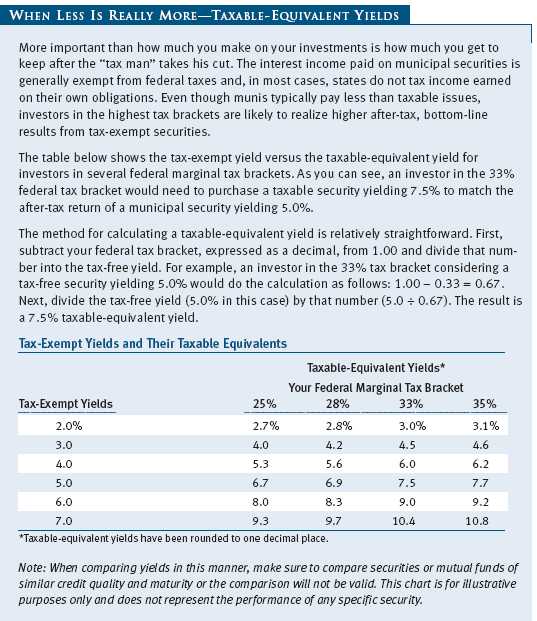
As subprime mortgage losses mounted in the last six months and banks significantly curtailed their lending activities in an attempt to avoid additional losses, the Federal Reserve took several actions to encourage lending, increase liquidity, and keep credit market turmoil from undercutting the economy. Perhaps the most far-reaching of these actions was a substantial, multistep reduction in the fed funds target rate—an interbank lending rate that banks also use as a benchmark for their prime lending rates to consumers—from 5.25% to 3.00% . Although inflation is currently higher than what monetary policy officials would prefer, the central bank seems poised to continue cutting rates in the months ahead to keep the economy from deteriorating further. (After our reporting period ended, the Fed reduced the fed funds rate to 2.25% on March 18.)

As shown in the graph, Georgia municipal bond yields remained relatively stable through much of our fiscal year before shooting higher as the period ended. Georgia was not alone in this pattern. Due to a substantial February sell-off in the municipal market, tax-free bond yields nationwide spiked sharply above the yields of Treasury bonds with similar maturities. As of February 29, 2008, for example, the 4.12% yield offered by a 10-year municipal bond rated AAA was an unprecedented 117% of the 3.51% yield offered by a 10-year Treasury. In comparison, high-quality 10-year municipal bonds have provided an average of about 81% of the yield offered by 10-year Treasuries since 1990. Based on current valuations and a continued belief that the municipal bond market is still a high-quality market, we believe that investors who are seeking tax-free income and are willing to endure this extraordinary period of volatility—which could last for some time—should consider taking advantage of what appears to be a great buying opportunity in the municipal bond market.
MUNICIPAL MARKET NEWS
New municipal issuance in 2007 reached a record $427 billion, according to The Bond Buyer, eclipsing the previous record of $408 billion in 2005. While demand from retail investors has been strong given the adjustment in tax-free interest rates, overall demand for tax-free securities from nontraditional investors, such as hedge funds and foreign entities, has slowed, which has contributed to municipal market weakness. Although conventional new supply is down so far in 2008, there has been an increase in secondary supply—stemming in part from the unwinding of structured transactions that create floating-rate securities from pools of long-term municipal bonds. In addition, tax-free bonds have been lagging in part because of concerns that the economic slowdown and falling real estate values will have an adverse impact on revenues collected by municipal governments.
The failure of the auction-rate securities (ARS) market in February is a relatively new concern for municipal investors. ARS typically have long-term maturities, but because they are structured with interest rates that are reset every seven, 28, or 35 days through an auction process, many have invested in these securities with the view that they could be treated as cash equivalents. Auctions have been failing because broker-dealers who typically support this market are either unable or unwilling to do so in the current environment. At this time, we believe that failures within the ARS market represent a liquidity issue, rather than a credit issue, and that the short-term credit implications for ARS issuers will be contained. However, an extended dislocation or a permanent end to this market in conjunction with the inability of certain issuers to refinance their debts could have a material impact on certain ARS issuers, particularly those with weaker financial situations.
Yet another negative factor affecting the municipal market is lingering uncertainty regarding monoline insurers that guarantee the timely repayment of bond principal and interest when an issuer defaults. Monoline insurers, which insure about half of the $2.5 trillion municipal bond market and are typically AAA rated by the major credit rating agencies, have come under substantial pressure due to apparently high exposure to structured financial products that house significant sub-prime mortgage risk. Downgrades of monoline insurance companies could compromise the related guarantees that they provide to a large portion of the municipal market and therefore lead to subsequent downgrades of the bonds they insure. This could force some portfolios to sell holdings whose ratings have fallen outside of a permissible range.
While we realize this negative environment may linger, we have a positive long-term outlook for the municipal asset class. Current valuations—with AAA tax-exempt yields higher than Treasury yields across all maturities—present an attractive option for taxable investors in any tax bracket. The municipal bond market remains a high-quality market, where about half of the outstanding bonds are rated AAA or AA without an insurance guarantee. Many of the concerns regarding the financial health of monoline insurers seem to have already been discounted by the municipal bond market. Valuations of municipals relative to Treasuries are at historically cheap levels.
At T. Rowe Price, as an ongoing and integral part of our municipal bond investment process, we have always evaluated the fundamental merits of the issuer of each municipal bond investment, whether the security is insured or not. We believe this rigorous attention to fundamental research will continue to reward our investors over the long term.
GEORGIA MARKET NEWS
Georgia’s economy rebounded strongly from the national economic recession that began in 2001. The state’s financial performance in fiscal years 2006 and 2007 resulted in healthy year-over-year revenue growth, leading to strong budget surpluses that were used to restore and strengthen the state’s rainy day fund. Georgia’s fiscal year 2007 operating revenue increased 7.5% over its fiscal year 2006 receipts, leading to a surplus of $1.1 billion. The state placed $767 million of the fiscal year 2007 surplus into the state’s revenue shortfall reserve, bringing its total to $1.73 billion.
To be sure, conditions have become more challenging lately. Through the first eight months of fiscal year 2008, the state’s revenue collections have increased just 1.9%, showing signs of a softening economy. The governor has continued to exhibit sound fiscal management and has responded to the slowdown in revenues by recommending that the state legislature pass his proposal to reduce the midyear fiscal year 2008 budget by $65 million. Governor Perdue has also proposed reducing the fiscal year 2009 budget by $332.6 million and has announced his intention to maintain a strong revenue shortfall reserve and continue to engage in sound fiscal management practices.
As of March 1, 2008, the state’s general obligation bonds were rated AAA by all three of the major rating agencies. The state has maintained these ratings for several years due to strong economic expansion and conservative debt and financial management. Georgia’s debt levels are limited by the state constitution, which mandates that maximum annual debt service is limited to 10% of total revenue receipts of the state treasury.
PERFORMANCE AND PORTFOLIO STRATEGY

The Georgia Tax-Free Bond Fund returned -2.11% and -3.15% for the 6- and 12-month periods ended February 29, 2008, respectively. While these results were again disappointing on an absolute basis, they also once again outpaced the Lipper peer group average. Dividends per share were unchanged over the past six months, although the fund’s yield increased as a result of a decline in net asset value. Our relative performance benefited from our short-term high-quality holdings, our sector allocations, and our low fees.

Another major factor benefiting our relative returns in the period was our underweight in insured bonds. As described above, many of these issues performed poorly due to turmoil among the monoline insurers, and insured bonds with weak underlying credits posted particularly poor results. This fund historically has been light on municipal bond insurance exposure, as we prefer to use T. Rowe Price’s in-house credit research and buy uninsured bonds. Further, when we have bought insured bonds, we have always reviewed the underlying credit to make sure it was something we would like to own even without insurance. As valuations of insured issues became compelling late in the period, we added somewhat to our holdings. By the end of the period, our direct exposure to bond insurance increased to about 40%, compared with the overall market weighting of 45%.
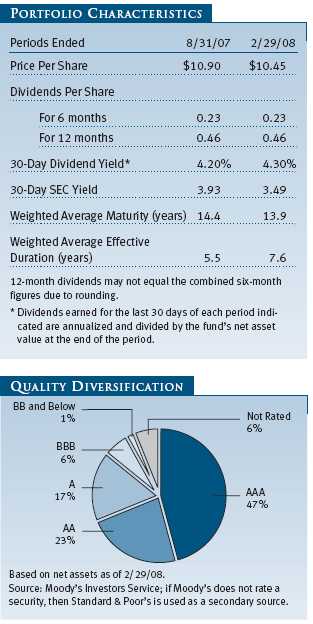
We could not escape all the market turmoil, however, and our lower-rated and lower-quality bonds detracted from returns in the downturn. Prepaid gas bonds struggled in particular as pressure on the financials sector in the corporate market spilled over to these securities in the municipal market. Poor performers included several positions issued by Main Street Natural Gas, which are backed by a guarantee by either J.P. Morgan Chase or Merrill Lynch. (Please see the portfolio of investments for a complete listing of holdings and the amount each represents in the portfolio.)
The fund’s interest rate positioning remained relatively constant despite the disruptions in the municipal market. We kept slightly more cash through the end of the period, as we wanted to keep some powder dry for any further market dislocations. As a result, our average maturity dropped, though rising rates contributed to a much longer duration at the end of the period.
From a sector perspective, the fund saw few changes over the past six months. We moderately reduced our hospital holdings, which helped results as hospital returns were weak this period. We also reduced our exposure to Puerto Rico general obligation bonds and related debt, as the commonwealth continues to face fiscal challenges and persistent fallout from a U.S. economic downturn. (Income from Puerto Rico debt is deductible for Georgia residents.) Although valuations for lower-quality, higher-yielding credits at the end of the period were much more compelling than at the outset, we added few holdings in the low-quality sectors over the last six months.
With municipals yielding more than Treasuries across all maturities, we expect to reduce our cash and buy longer-dated issues in the coming months. While there may be near-term volatility, we expect that the prospect for good relative returns in our market is greatly improved. As always, we will seek to continue delivering superior returns for our shareholders through our low fees, the strong research of our credit analysts, and the opportunistic investing of our trading team.
OUTLOOK
Since last August, the Federal Reserve has slashed the fed funds target rate and introduced a series of measures to provide more liquidity to the markets in an attempt to prevent ongoing financial market disruptions from spilling over into the broader economy. Nevertheless, the housing sector continues to weaken, and the likelihood of slower economic and job growth in the months ahead should permit the Fed to authorize additional interest rate cuts.
We believe the relative weakness of tax-free securities and the widening of credit spreads between higher- and lower-quality municipal securities in the last six months have been driven primarily by the flight to U.S. government securities and reduced liquidity, rather than fundamental municipal credit concerns. In light of generally favorable fundamentals for the municipal market, we believe tax-exempt bonds now offer very compelling values relative to taxable bonds for investors in all tax brackets. In fact, valuations are more attractive than at any time in recent memory.
T. Rowe Price’s municipal bond portfolio managers and credit analysts are monitoring the municipal market very carefully and are identifying opportunities to invest in securities with attractive yields and a good risk/reward tradeoff. Before investing, we will continue to rely on our rigorous, independent research to evaluate the fundamental merits of the issuer of each security under consideration.
Respectfully submitted,

Hugh D. McGuirk
Chairman of the Investment Advisory Committee
March 20, 2008
The committee chairman has day-to-day responsibility for managing the portfolio and works with committee members in developing and executing the fund’s investment program.
RISKS OF INVESTING
As with all mutual funds, the fund’s share price can fall because of weakness in the markets, a particular industry, or specific holdings. Yield and share price will vary with interest rate changes. Investors should note that if interest rates rise significantly from current levels, the fund’s share price will decline and may even turn negative in the short term. There is also a chance that some of the fund’s holdings may have their credit rating downgraded or may default. The fund is less diversified than one investing nationally. Some income may be subject to state and local taxes and the federal alternative minimum tax.
GLOSSARY
30-day SEC yield: A method of calculating a fund’s yield that assumes all portfolio securities are held until maturity. The Securities and Exchange Commission (SEC) requires all bond funds to calculate this yield. Yield will vary and is not guaranteed.
Average maturity: The weighted average of the stated maturity dates of the portfolio’s securities. In general, the longer the average maturity, the greater the fund’s sensitivity to interest rate changes. A shorter average maturity usually means less interest rate sensitivity and therefore a less volatile portfolio.
Basis point: One one-hundredth of one percentage point, or 0.01% .
Duration: A measure of a bond fund’s sensitivity to changes in interest rates. For example, a fund with a duration of six years would fall about 6% in price in response to a one-percentage-point rise in interest rates, and vice versa.
Federal funds rate: The interest rate charged on overnight loans of reserves by one financial institution to another in the United States. The Federal Reserve sets a target federal funds rate to affect the direction of interest rates.
Investment grade: High-quality bonds as measured by one of the major credit rating agencies. For example, Standard & Poor’s designates the bonds in its top four categories (AAA to BBB) as investment grade.
Lehman Brothers Municipal Bond Index: An unmanaged index that includes investment-grade, tax-exempt, and fixed-rate bonds.
Lehman Brothers U.S. Aggregate Index: An unmanaged index that tracks domestic investment-grade bonds, including corporate, government, and mortgage-backed securities.
Lipper averages: The averages of available mutual fund performance returns for specified time periods in defined categories as tracked by Lipper Inc.
Tender option bonds: Obligations that grant the bondholder the right to require the issuer (or a specified third party acting as agent for the issuer) to purchase the bonds, usually at par, at a specified time or times prior to maturity or upon the occurrence of certain events or conditions.
Yield curve: A graph depicting the relationship between yields and maturity dates for a set of similar securities. These curves are in constant flux. One of the key activities in managing any fixed-income portfolio is to study trends reflected by comparative yield curves.
Performance and Expenses
This chart shows the value of a hypothetical $10,000 investment in the fund over the past 10 fiscal year periods or since inception (for funds lacking 10-year records). The result is compared with benchmarks, which may include a broad-based market index and a peer group average or index. Market indexes do not include expenses, which are deducted from fund returns as well as mutual fund averages and indexes.

| AVERAGE ANNUAL COMPOUND TOTAL RETURN |
This table shows how the fund would have performed each year if its actual (or cumulative) returns for the periods shown had been earned at a constant rate.

As a mutual fund shareholder, you may incur two types of costs: (1) transaction costs, such as redemption fees or sales loads, and (2) ongoing costs, including management fees, distribution and service (12b-1) fees, and other fund expenses. The following example is intended to help you understand your ongoing costs (in dollars) of investing in the fund and to compare these costs with the ongoing costs of investing in other mutual funds. The example is based on an investment of $1,000 invested at the beginning of the most recent six-month period and held for the entire period.
Actual Expenses
The first line of the following table (“Actual”) provides information about actual account values and expenses based on the fund’s actual returns. You may use the information in this line, together with your account balance, to estimate the expenses that you paid over the period. Simply divide your account value by $1,000 (for example, an $8,600 account value divided by $1,000 = 8.6), then multiply the result by the number in the first line under the heading “Expenses Paid During Period” to estimate the expenses you paid on your account during this period.
Hypothetical Example for Comparison Purposes
The information on the second line of the table (“Hypothetical”) is based on hypothetical account values and expenses derived from the fund’s actual expense ratio and an assumed 5% per year rate of return before expenses (not the fund’s actual return). You may compare the ongoing costs of investing in the fund with other funds by contrasting this 5% hypothetical example and the 5% hypothetical examples that appear in the shareholder reports of the other funds. The hypothetical account values and expenses may not be used to estimate the actual ending account balance or expenses you paid for the period.
Note: T. Rowe Price charges an annual small-account maintenance fee of $10, generally for accounts with less than $2,000 ($500 for UGMA/UTMA). The fee is waived for any investor whose T. Rowe Price mutual fund accounts total $25,000 or more, accounts employing automatic investing, and IRAs and other retirement plan accounts that utilize a prototype plan sponsored by T. Rowe Price (although a separate custodial or administrative fee may apply to such accounts). This fee is not included in the accompanying table. If you are subject to the fee, keep it in mind when you are estimating the ongoing expenses of investing in the fund and when comparing the expenses of this fund with other funds.
You should also be aware that the expenses shown in the table highlight only your ongoing costs and do not reflect any transaction costs, such as redemption fees or sales loads. Therefore, the second line of the table is useful in comparing ongoing costs only and will not help you determine the relative total costs of owning different funds. To the extent a fund charges transaction costs, however, the total cost of owning that fund is higher.
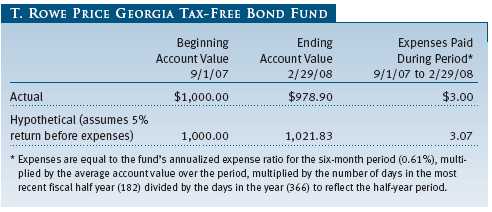
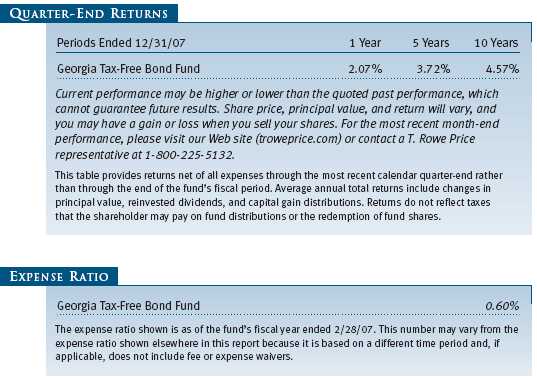
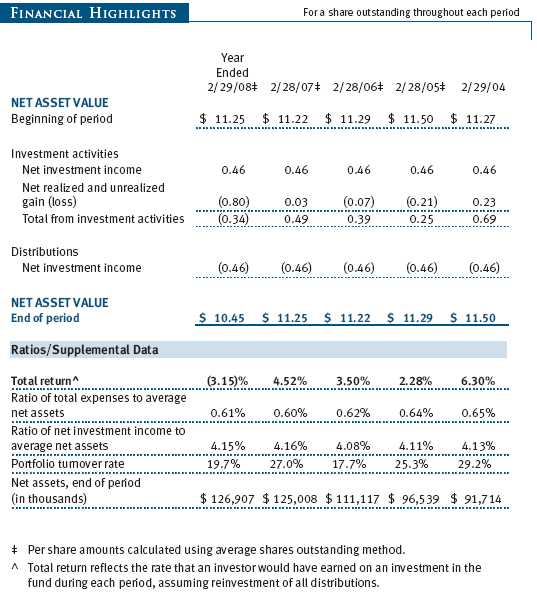
The accompanying notes are an integral part of these financial statements.
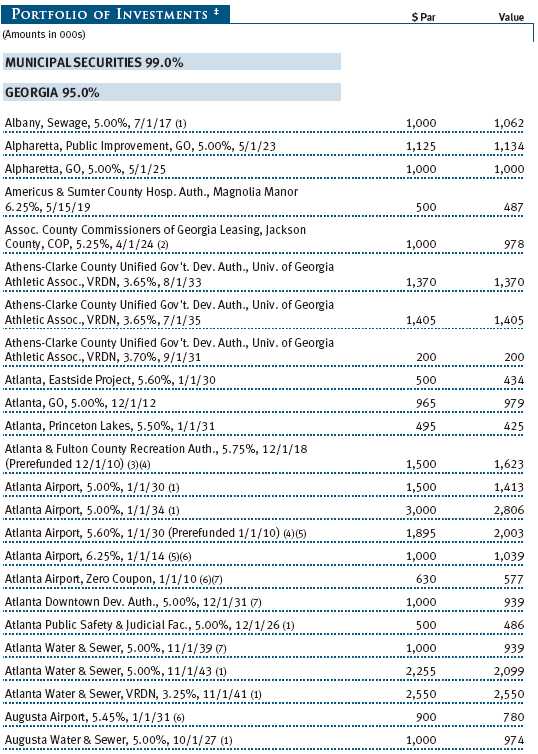
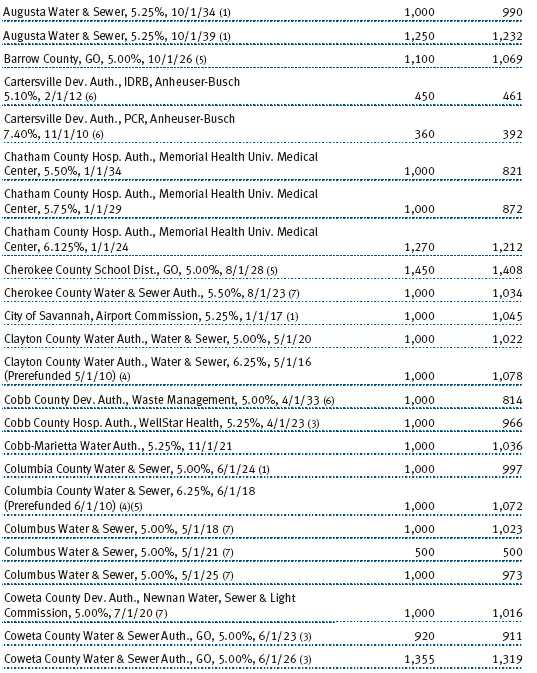
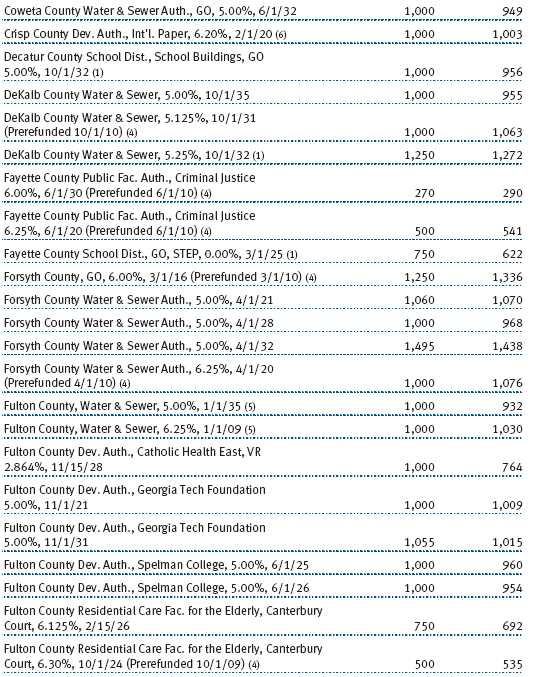

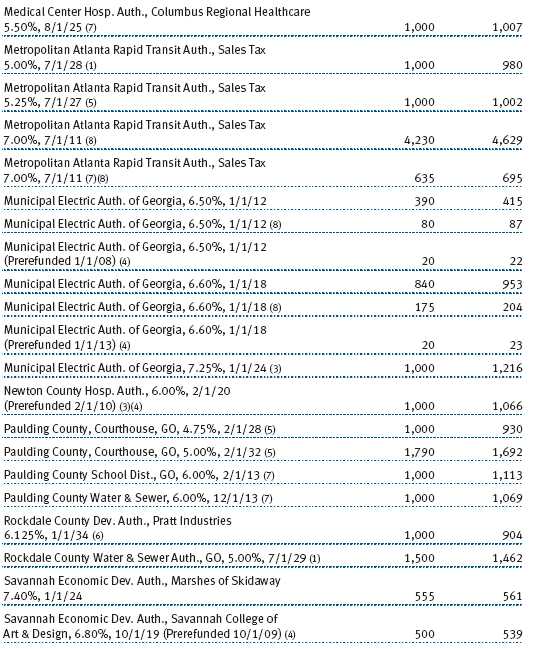
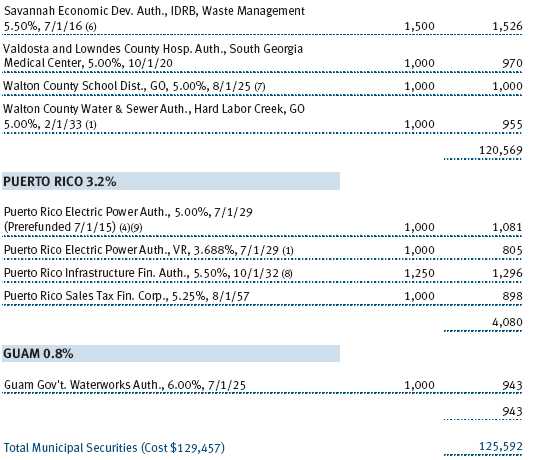
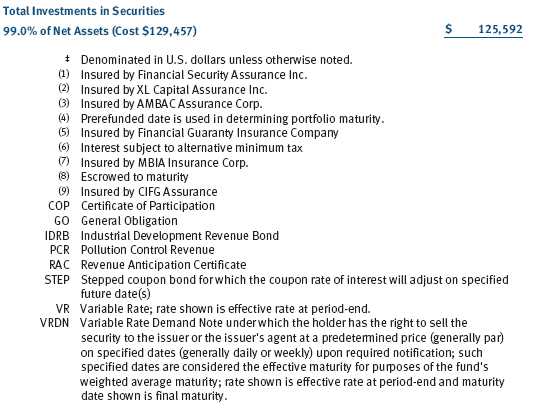
The accompanying notes are an integral part of these financial statements.
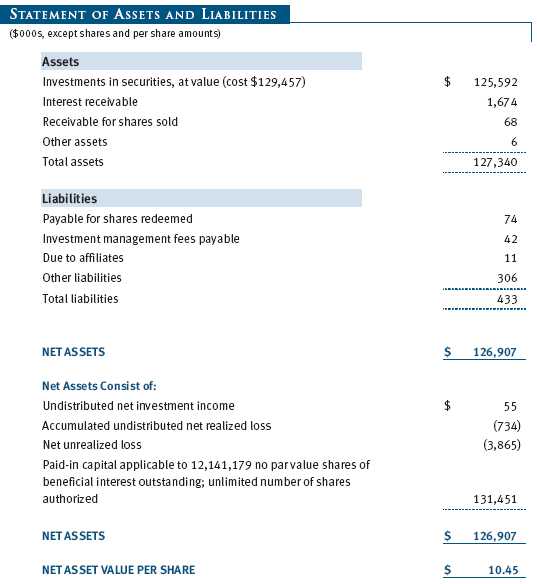
The accompanying notes are an integral part of these financial statements.
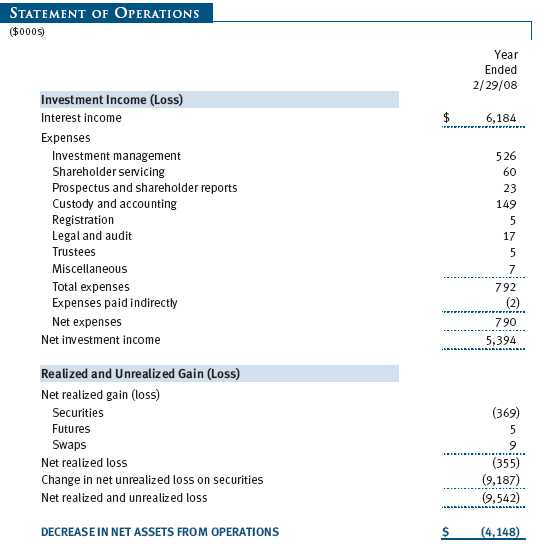
The accompanying notes are an integral part of these financial statements.
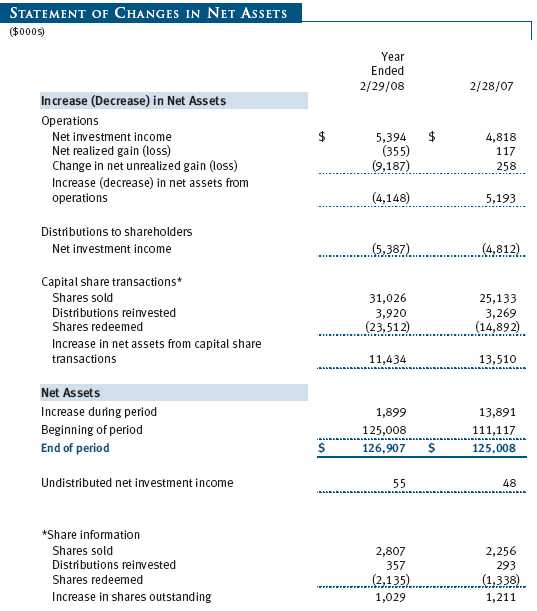
The accompanying notes are an integral part of these financial statements.
| NOTES TO FINANCIAL STATEMENTS |
NOTE 1 - SIGNIFICANT ACCOUNTING POLICIES
T. Rowe Price State Tax-Free Income Trust (the trust), is registered under the Investment Company Act of 1940 (the 1940 Act). The Georgia Tax-Free Bond Fund (the fund), a nondiversified, open-end management investment company, is one portfolio established by the trust. The fund commenced operations on March 31, 1993. The fund seeks to provide, consistent with prudent portfolio management, the highest level of income exempt from federal and Georgia state income taxes, by investing primarily in investment-grade Georgia municipal bonds.
The accompanying financial statements were prepared in accordance with accounting principles generally accepted in the United States of America, which require the use of estimates made by fund management. Fund management believes that estimates and security valuations are appropriate; however, actual results may differ from those estimates, and the security valuations reflected in the financial statements may differ from the value the fund ultimately realizes upon sale of the securities.
Valuation The fund values its investments and computes its net asset value per share at the close of the New York Stock Exchange (NYSE), normally 4 p.m. ET, each day that the NYSE is open for business. Debt securities are generally traded in the over-the-counter market. Securities with original maturities of one year or more are valued at prices furnished by dealers who make markets in such securities or by an independent pricing service, which considers yield or price of bonds of comparable quality, coupon, maturity, and type, as well as prices quoted by dealers who make markets in such securities. Securities with original maturities of less than one year are valued at amortized cost in local currency, which approximates fair value when combined with accrued interest.
Financial futures contracts are valued at closing settlement prices. Swap agreements are valued at prices furnished by dealers who make markets in such securities or by an independent pricing service.
Other investments, including restricted securities, and those for which the above valuation procedures are inappropriate or are deemed not to reflect fair value are stated at fair value as determined in good faith by the T. Rowe Price Valuation Committee, established by the fund’s Board of Trustees.
Credits The fund earns credits on temporarily uninvested cash balances at the custodian that reduce the fund’s custody charges. Custody expense in the accompanying financial statements is presented before reduction for credits, which are reflected as expenses paid indirectly.
Investment Transactions, Investment Income, and Distributions Income and expenses are recorded on the accrual basis. Premiums and discounts on debt securities are amortized for financial reporting purposes. Income tax-related interest and penalties, if incurred, would be recorded as income tax expense. Investment transactions are accounted for on the trade date. Realized gains and losses are reported on the identified cost basis. Payments (“variation margin”) made or received to settle the daily fluctuations in the value of futures contracts are recorded as unrealized gains or losses until the contracts are closed. Net periodic receipts or payments required by swaps are accrued daily and recorded as realized gain or loss in the accompanying financial statements. Fluctuations in the fair value of swaps are reflected in the change in net unrealized gain or loss and are reclassified to realized gain or loss upon termination prior to maturity. Distributions to shareholders are recorded on the ex-dividend date. Income distributions are declared on a daily basis and paid monthly. Capital gain distributions, if any, are declared and paid by the fund, typically on an annual basis.
New Accounting Pronouncements Effective August 31, 2007, the fund adopted Financial Accounting Standards Board (FASB) Interpretation No. 48 (FIN 48), Accounting for Uncertainty in Income Taxes, a clarification of FASB Statement No. 109, Accounting for Income Taxes. FIN 48 establishes financial accounting and disclosure requirements for recognition and measurement of tax positions taken or expected to be taken on an income tax return. The adoption of FIN 48 had no impact on the fund’s net assets or results of operations.
In September 2006, the FASB released the Statement of Financial Accounting Standard No. 157 (FAS 157), Fair Value Measurements. FAS 157 clarifies the definition of fair value and establishes the framework for measuring fair value, as well as proper disclosure of this methodology in the financial statements. It will be effective for the fund’s fiscal year beginning March 1, 2008. Management is evaluating the effects of FAS 157; however, it is not expected to have a material impact on the fund’s net assets or results of operations.
NOTE 2 - INVESTMENT TRANSACTION
Consistent with its investment objective, the fund engages in the following practices to manage exposure to certain risks or to enhance performance. The investment objective, policies, program, and risk factors of the fund are described more fully in the fund’s prospectus and Statement of Additional Information.
Futures Contracts During the year ended February 29, 2008, the fund was a party to futures contracts, which provide for the future sale by one party and purchase by another of a specified amount of a specific financial instrument at an agreed upon price, date, time, and place. Risks arise from possible illiquidity of the futures market and from movements in security values and/or interest rates.
Swaps During the year ended February 29, 2008, the fund was a party to interest rate swaps under which it is obligated to exchange cash flows based on the difference between specified interest rates applied to a notional principal amount for a specified period of time. Risks arise from the possible inability of counterparties to meet the terms of their agreements and from movements in interest rates. In order to mitigate counterparty risk and subject to specific contractual arrangements, the fund may receive eligible security collateral from such counterparties upon unrealized gain amounts reaching certain thresholds. Eligible security collateral generally includes debt securities issued by the U.S. government or related agencies. At February 29, 2008, no such collateral was received.
Other Purchases and sales of portfolio securities, other than short-term securities, aggregated $32,085,000 and $24,794,000, respectively, for the year ended February 29, 2008.
NOTE 3 - FEDERAL INCOME TAXES
No provision for federal income taxes is required since the fund intends to continue to qualify as a regulated investment company under Subchapter M of the Internal Revenue Code and distribute to shareholders all of its income and gains. Federal income tax regulations differ from generally accepted accounting principles; therefore, distributions determined in accordance with tax regulations may differ significantly in amount or character from net investment income and realized gains for financial reporting purposes. Financial reporting records are adjusted for permanent book/tax differences to reflect tax character. Financial records are not adjusted for temporary differences.
Distributions during the year ended February 29, 2008, totaled $5,387,000 and were characterized as tax-exempt income for tax purposes. At February 29, 2008, the tax-basis components of net assets were as follows:
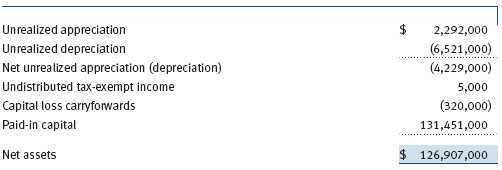
Federal income tax regulations require the fund to defer recognition of capital losses realized on certain futures transactions; accordingly, $305,000 of realized losses reflected in the accompanying financial statements have not been recognized for tax purposes as of February 29, 2008. The fund intends to retain realized gains to the extent of available capital loss carryforwards. As of February 29, 2008, the fund had $320,000 of capital loss carryforwards that expire in fiscal 2016.
At February 29, 2008, the cost of investments for federal income tax purposes was $129,821,000.
NOTE 4 - RELATED PARTY TRANSACTIONS
The fund is managed by T. Rowe Price Associates, Inc. (the manager or Price Associates), a wholly owned subsidiary of T. Rowe Price Group, Inc. The investment management agreement between the fund and the manager provides for an annual investment management fee, which is computed daily and paid monthly. The fee consists of an individual fund fee, equal to 0.10% of the fund’s average daily net assets, and a group fee. The group fee rate is calculated based on the combined net assets of certain mutual funds sponsored by Price Associates (the group) applied to a graduated fee schedule, with rates ranging from 0.48% for the first $1 billion of assets to 0.285% for assets in excess of $220 billion. The fund’s group fee is determined by applying the group fee rate to the fund’s average daily net assets. At February 29, 2008, the effective annual group fee rate was 0.30%.
In addition, the fund has entered into service agreements with Price Associates and a wholly owned subsidiary of Price Associates (collectively, Price). Price Associates computes the daily share price and provides certain other administrative services to the fund. T. Rowe Price Services, Inc., provides shareholder and administrative services in its capacity as the fund’s transfer and dividend disbursing agent. For the year ended February 29, 2008, expenses incurred pursuant to these service agreements were $99,000 for Price Associates and $42,000 for T. Rowe Price Services, Inc. The total amount payable at period-end pursuant to these service agreements is reflected as Due to Affiliates in the accompanying financial statements.
| REPORT OF INDEPENDENT REGISTERED PUBLIC ACCOUNTING FIRM |
To the Board of Trustees of T. Rowe Price State Tax-Free Income Trust and Shareholders of T. Rowe Price Georgia Tax-Free Bond Fund
In our opinion, the accompanying statement of assets and liabilities, including the portfolio of investments, and the related statements of operations and of changes in net assets and the financial highlights present fairly, in all material respects, the financial position of T. Rowe Price Georgia Tax-Free Bond Fund (one of the portfolios comprising T. Rowe Price State Tax-Free Income Trust, hereafter referred to as the “Fund”) at February 29, 2008, the results of its operations for the year then ended, the changes in its net assets for each of the two years in the period then ended and the financial highlights for each of the five years in the period then ended, in conformity with accounting principles generally accepted in the United States of America. These financial statements and financial highlights (hereafter referred to as “financial statements”) are the responsibility of the Fund’s management; our responsibility is to express an opinion on these financial statements based on our audits. We conducted our audits of these financial statements in accordance with the auditing standards of the Public Company Accounting Oversight Board (United States). Those standards require that we plan and perform the audit to obtain reasonable assurance about whether the financial statements are free of material misstatement. An audit includes examining, on a test basis, evidence supporting the amounts and disclosures in the financial statements, assessing the accounting principles used and significant estimates made by management, and evaluating the overall financial statement presentation. We believe that our audits, which included confirmation of securities at February 29, 2008, by correspondence with the custodian, provide a reasonable basis for our opinion.
PricewaterhouseCoopers LLP
Baltimore, Maryland
April 11, 2008
| TAX INFORMATION (UNAUDITED) FOR THE TAX YEAR ENDED 2/29/08 |
We are providing this information as required by the Internal Revenue Code. The amounts shown may differ from those elsewhere in this report because of differences between tax and financial reporting requirements.
The fund’s distributions to shareholders included $5,354,000 which qualified as exempt-interest dividends.
| INFORMATION ON PROXY VOTING POLICIES, PROCEDURES, AND RECORDS |
A description of the policies and procedures used by T. Rowe Price funds and portfolios to determine how to vote proxies relating to portfolio securities is available in each fund’s Statement of Additional Information, which you may request by calling 1-800-225-5132 or by accessing the SEC’s Web site, www.sec.gov. The description of our proxy voting policies and procedures is also available on our Web site, www.troweprice.com. To access it, click on the words “Company Info” at the top of our homepage for individual investors. Then, in the window that appears, click on the “Proxy Voting Policy” navigation button in the top left corner.
Each fund’s most recent annual proxy voting record is available on our Web site and through the SEC’s Web site. To access it through our Web site, follow the directions above, then click on the words “Proxy Voting Record” at the bottom of the Proxy Voting Policy page.
| HOW TO OBTAIN QUARTERLY PORTFOLIO HOLDINGS |
The fund files a complete schedule of portfolio holdings with the Securities and Exchange Commission for the first and third quarters of each fiscal year on Form N-Q. The fund’s Form N-Q is available electronically on the SEC’s Web site (www.sec.gov); hard copies may be reviewed and copied at the SEC’s Public Reference Room, 450 Fifth St. N.W., Washington, DC 20549. For more information on the Public Reference Room, call 1-800-SEC-0330.
| ABOUT THE FUND’S TRUSTEES AND OFFICERS |
Your fund is governed by a Board of Trustees (Board) that meets regularly to review a wide variety of matters affecting the fund, including performance, investment programs, compliance matters, advisory fees and expenses, service providers, and other business affairs. The Board elects the fund’s officers, who are listed in the final table. At least 75% of Board members are independent of T. Rowe Price Associates, Inc. (T. Rowe Price), and T. Rowe Price International, Inc. (T. Rowe Price International); “inside” or “interested” trustees are employees or officers of T. Rowe Price. The business address of each trustee and officer is 100 East Pratt Street, Baltimore, Maryland 21202. The Statement of Additional Information includes additional information about the trustees and is available without charge by calling a T. Rowe Price representative at 1-800-225-5132.
| Independent Trustees | |
| |
| Name | |
| (Year of Birth) | Principal Occupation(s) During Past 5 Years and Directorships of |
| Year Elected* | Other Public Companies |
| |
| Jeremiah E. Casey | Director, National Life Insurance (2001 to 2005); Director, The Rouse |
| (1940) | Company, real estate developers (1990 to 2004) |
| 2006 | |
| |
| Anthony W. Deering | Chairman, Exeter Capital, LLC, a private investment firm (2004 to |
| (1945) | present); Director, Vornado Real Estate Investment Trust (3/04 to |
| 1986 | present); Director, Mercantile Bankshares (2002 to 2007); Member, |
| | Advisory Board, Deutsche Bank North America (2004 to present); |
| | Director, Chairman of the Board, and Chief Executive Officer, The |
| | Rouse Company, real estate developers (1997 to 2004) |
| |
| Donald W. Dick, Jr. | Principal, EuroCapital Advisors, LLC, an acquisition and management |
| (1943) | advisory firm (10/95 to present); Chairman, The Haven Group, a |
| 2001 | custom manufacturer of modular homes (1/04 to present) |
| |
| David K. Fagin | Chairman and President, Nye Corporation (6/88 to present); |
| (1938) | Chairman, Canyon Resources Corp. (8/07 to present); Director, |
| 2001 | Golden Star Resources Ltd. (5/92 to present); Director, Pacific Rim |
| | Mining Corp. (2/02 to present) |
| |
| Karen N. Horn | Director, Federal National Mortgage Association (9/06 to present); |
| (1943) | Managing Director and President, Global Private Client Services, |
| 2003 | Marsh Inc. (1999 to 2003); Director, Eli Lilly and Company and |
| | Simon Property Group |
| |
| Theo C. Rodgers | President, A&R Development Corporation (1977 to present) |
| (1941) | |
| 2005 | |
| John G. Schreiber | Owner/President, Centaur Capital Partners, Inc., a real estate invest- |
| (1946) | ment company (1991 to present); Partner, Blackstone Real Estate |
| 1992 | Advisors, L.P. (10/92 to present) |
| |
| *Each independent trustee oversees 122 T. Rowe Price portfolios and serves until retirement, resignation, |
| or election of a successor. | |
| Inside Trustees | |
| |
| Name | |
| (Year of Birth) | |
| Year Elected* | |
| [Number of T. Rowe Price | Principal Occupation(s) During Past 5 Years and Directorships of |
| Portfolios Overseen] | Other Public Companies |
| |
| Edward C. Bernard | Director and Vice President, T. Rowe Price; Vice Chairman of the |
| (1956) | Board, Director, and Vice President, T. Rowe Price Group, Inc.; |
| 2006 | Chairman of the Board, Director, and President, T. Rowe Price |
| [122] | Investment Services, Inc.; Chairman of the Board and Director, |
| | T. Rowe Price Global Asset Management Limited, T. Rowe Price Global |
| | Investment Services Limited, T. Rowe Price Retirement Plan Services, |
| | Inc., T. Rowe Price Savings Bank, and T. Rowe Price Services, Inc.; |
| | Director, T. Rowe Price International, Inc.; Chief Executive Officer, |
| | Chairman of the Board, Director, and President, T. Rowe Price Trust |
| | Company; Chairman of the Board, all funds |
| |
| Mary J. Miller, CFA | Director, T. Rowe Price Trust Company; Director and Vice President, |
| (1955) | T. Rowe Price; Vice President, T. Rowe Price Group, Inc.; President, |
| 2004 | State Tax-Free Income Trust |
| [38] | |
| |
| *Each inside trustee serves until retirement, resignation, or election of a successor. |
| Officers | |
| |
| Name (Year of Birth) | |
| Title and Fund(s) Served | Principal Occupation(s) |
| |
| Joseph A. Carrier, CPA (1960) | Vice President, T. Rowe Price, T. Rowe Price |
| Treasurer, State Tax-Free Income Trust | Group, Inc., T. Rowe Price Investment Services, |
| | Inc., and T. Rowe Price Trust Company |
| |
| Jonathan M. Chirunga (1966) | Vice President, T. Rowe Price and T. Rowe Price |
| Vice President, State Tax-Free Income Trust | Group, Inc. |
| |
| M. Helena Condez (1962) | Assistant Vice President, T. Rowe Price |
| Assistant Vice President, State Tax-Free | |
| Income Trust | |
| |
| G. Richard Dent (1960) | Vice President, T. Rowe Price and T. Rowe Price |
| Vice President, State Tax-Free Income Trust | Group, Inc. |
| |
| Roger L. Fiery III, CPA (1959) | Vice President, T. Rowe Price, T. Rowe Price |
| Vice President, State Tax-Free Income Trust | Group, Inc., T. Rowe Price International, Inc., |
| | and T. Rowe Price Trust Company |
| |
| Kathryn A. Floyd (1982) | Assistant Vice President, T. Rowe Price; formerly |
| Assistant Vice President, State Tax-Free | student, University of Virginia, McIntire School |
| Income Trust | of Commerce (to 2004) |
| |
| John R. Gilner (1961) | Chief Compliance Officer and Vice President, |
| Chief Compliance Officer, State Tax-Free | T. Rowe Price; Vice President, T. Rowe Price |
| Income Trust | Group, Inc., and T. Rowe Price Investment |
| | Services, Inc. |
| |
| Gregory S. Golczewski (1966) | Vice President, T. Rowe Price and T. Rowe Price |
| Vice President, State Tax-Free Income Trust | Trust Company |
| |
| Charles B. Hill, CFA (1961) | Vice President, T. Rowe Price and T. Rowe Price |
| Executive Vice President, State Tax-Free | Group, Inc. |
| Income Trust | |
| |
| Henry H. Hopkins (1942) | Director and Vice President, T. Rowe Price |
| Vice President, State Tax-Free | Investment Services, Inc., T. Rowe Price |
| Income Trust | Services, Inc., and T. Rowe Price Trust Company; |
| | Vice President, T. Rowe Price, T. Rowe Price |
| | Group, Inc., T. Rowe Price International, Inc., |
| | and T. Rowe Price Retirement Plan Services, Inc. |
| Marcy M. Lash (1963) | Vice President, T. Rowe Price and T. Rowe Price |
| Vice President, State Tax-Free Income Trust | Group, Inc. |
| |
| Alan D. Levenson, Ph.D. (1958) | Vice President, T. Rowe Price and T. Rowe Price |
| Vice President, State Tax-Free Income Trust | Group, Inc. |
| |
| Patricia B. Lippert (1953) | Assistant Vice President, T. Rowe Price and |
| Secretary, State Tax-Free Income Trust | T. Rowe Price Investment Services, Inc. |
| |
| Joseph K. Lynagh, CFA (1958) | Vice President, T. Rowe Price and T. Rowe Price |
| Executive Vice President, State Tax-Free | Group, Inc. |
| Income Trust | |
| |
| Konstantine B. Mallas (1963) | Vice President, T. Rowe Price and T. Rowe Price |
| Executive Vice President, State Tax-Free | Group, Inc. |
| Income Trust | |
| |
| James M. McDonald (1949) | Vice President, T. Rowe Price, T. Rowe Price |
| Vice President, State Tax-Free Income Trust | Group, Inc., and T. Rowe Price Trust Company |
| |
| Hugh D. McGuirk, CFA (1960) | Vice President, T. Rowe Price and T. Rowe Price |
| Executive Vice President, State Tax-Free | Group, Inc. |
| Income Trust | |
| |
| Linda A. Murphy (1959) | Vice President, T. Rowe Price and T. Rowe Price |
| Vice President, State Tax-Free Income Trust | Group, Inc. |
| |
| Timothy G. Taylor, CFA (1975) | Vice President, T. Rowe Price |
| Vice President, State Tax-Free Income Trust | |
| |
| Julie L. Waples (1970) | Vice President, T. Rowe Price |
| Vice President, State Tax-Free Income Trust | |
| |
| Unless otherwise noted, officers have been employees of T. Rowe Price or T. Rowe Price International |
| for at least five years. | |
Item 2. Code of Ethics.
The registrant has adopted a code of ethics, as defined in Item 2 of Form N-CSR, applicable to its principal executive officer, principal financial officer, principal accounting officer or controller, or persons performing similar functions. A copy of this code of ethics is filed as an exhibit to this Form N-CSR. No substantive amendments were approved or waivers were granted to this code of ethics during the period covered by this report.
Item 3. Audit Committee Financial Expert.
The registrant’s Board of Directors/Trustees has determined that Ms. Karen N. Horn qualifies as an audit committee financial expert, as defined in Item 3 of Form N-CSR. Ms. Horn is considered independent for purposes of Item 3 of Form N-CSR.
Item 4. Principal Accountant Fees and Services.
(a) – (d) Aggregate fees billed to the registrant for the last two fiscal years for professional services rendered by the registrant’s principal accountant were as follows:

Audit fees include amounts related to the audit of the registrant’s annual financial statements and services normally provided by the accountant in connection with statutory and regulatory filings. Audit-related fees include amounts reasonably related to the performance of the audit of the registrant’s financial statements and specifically include the issuance of a report on internal controls and, if applicable, agreed-upon procedures related to fund acquisitions. Tax fees include amounts related to services for tax compliance, tax planning, and tax advice. The nature of these services specifically includes the review of distribution calculations and the preparation of Federal, state, and excise tax returns. All other fees include the registrant’s pro-rata share of amounts for agreed-upon procedures in conjunction with service contract approvals by the registrant’s Board of Directors/Trustees.
(e)(1) The registrant’s audit committee has adopted a policy whereby audit and non-audit services performed by the registrant’s principal accountant for the registrant, its investment adviser, and any entity controlling, controlled by, or under common control with the investment adviser that provides ongoing services to the registrant require pre-approval in advance at regularly scheduled audit committee meetings. If such a service is required between regularly scheduled audit committee meetings, pre-approval may be authorized by one audit committee member with ratification at the next scheduled audit committee meeting. Waiver of pre-approval for audit or non-audit services requiring fees of a de minimis amount is not permitted.
(2) No services included in (b) – (d) above were approved pursuant to paragraph (c)(7)(i)(C) of Rule 2-01 of Regulation S-X.
(f) Less than 50 percent of the hours expended on the principal accountant’s engagement to audit the registrant’s financial statements for the most recent fiscal year were attributed to work performed by persons other than the principal accountant’s full-time, permanent employees.
(g) The aggregate fees billed for the most recent fiscal year and the preceding fiscal year by the registrant’s principal accountant for non-audit services rendered to the registrant, its investment adviser, and any entity controlling, controlled by, or under common control with the investment adviser that provides ongoing services to the registrant were $1,486,000 and $1,263,000, respectively, and were less than the aggregate fees billed for those same periods by the registrant’s principal accountant for audit services rendered to the T. Rowe Price Funds.
(h) All non-audit services rendered in (g) above were pre-approved by the registrant’s audit committee. Accordingly, these services were considered by the registrant’s audit committee in maintaining the principal accountant’s independence.
Item 5. Audit Committee of Listed Registrants.
Not applicable.
Item 6. Schedule of Investments.
Not applicable. The complete schedule of investments is included in Item 1 of this Form N-CSR.
Item 7. Disclosure of Proxy Voting Policies and Procedures for Closed-End Management Investment Companies.
Not applicable.
Item 8. Portfolio Managers of Closed-End Management Investment Companies.
Not applicable.
Item 9. Purchases of Equity Securities by Closed-End Management Investment Company and Affiliated Purchasers.
Not applicable.
Item 10. Submission of Matters to a Vote of Security Holders.
Not applicable.
Item 11. Controls and Procedures.
(a) The registrant’s principal executive officer and principal financial officer have evaluated the registrant’s disclosure controls and procedures within 90 days of this filing and have concluded that the registrant’s disclosure controls and procedures were effective, as of that date, in ensuring that information required to be disclosed by the registrant in this Form N-CSR was recorded, processed, summarized, and reported timely.
(b) The registrant’s principal executive officer and principal financial officer are aware of no change in the registrant’s internal control over financial reporting that occurred during the registrant’s second fiscal quarter covered by this report that has materially affected, or is reasonably likely to materially affect, the registrant’s internal control over financial reporting.
Item 12. Exhibits.
(a)(1) The registrant’s code of ethics pursuant to Item 2 of Form N-CSR is attached.
(2) Separate certifications by the registrant's principal executive officer and principal financial officer, pursuant to Section 302 of the Sarbanes-Oxley Act of 2002 and required by Rule 30a-2(a) under the Investment Company Act of 1940, are attached.
(3) Written solicitation to repurchase securities issued by closed-end companies: not applicable.
(b) A certification by the registrant's principal executive officer and principal financial officer, pursuant to Section 906 of the Sarbanes-Oxley Act of 2002 and required by Rule 30a-2(b) under the Investment Company Act of 1940, is attached.
| | |
SIGNATURES |
| |
| | Pursuant to the requirements of the Securities Exchange Act of 1934 and the Investment |
| Company Act of 1940, the registrant has duly caused this report to be signed on its behalf by the |
| undersigned, thereunto duly authorized. |
| |
| T. Rowe Price State Tax-Free Income Trust |
| |
| |
| |
| By | /s/ Edward C. Bernard |
| | Edward C. Bernard |
| | Principal Executive Officer |
| |
| Date | April 18, 2008 |
| |
| |
| |
| | Pursuant to the requirements of the Securities Exchange Act of 1934 and the Investment |
| Company Act of 1940, this report has been signed below by the following persons on behalf of |
| the registrant and in the capacities and on the dates indicated. |
| |
| |
| By | /s/ Edward C. Bernard |
| | Edward C. Bernard |
| | Principal Executive Officer |
| |
| Date | April 18, 2008 |
| |
| |
| |
| By | /s/ Gregory K. Hinkle |
| | Gregory K. Hinkle |
| | Principal Financial Officer |
| |
| Date | April 18, 2008 |























